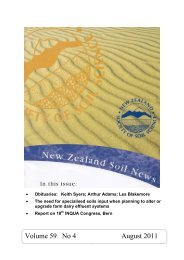Volume 55 No 2 April 2007 - New Zealand Society of Soil Science
Volume 55 No 2 April 2007 - New Zealand Society of Soil Science
Volume 55 No 2 April 2007 - New Zealand Society of Soil Science
You also want an ePaper? Increase the reach of your titles
YUMPU automatically turns print PDFs into web optimized ePapers that Google loves.
heralded the beginning <strong>of</strong> soil survey in what was to subsequently become the Department <strong>of</strong><br />
Scientific and Industrial Research (DSIR).<br />
Reorganization <strong>of</strong> science to form the DSIR<br />
Government science was reorganized in 1926, with Dr Ernest Marsden appointed Secretary to the<br />
Council and Department <strong>of</strong> Scientific and Industrial Research (DSIR). The Geological Survey and<br />
Dominion Laboratory were incorporated into the new department but Astons laboratory remained in<br />
the Department <strong>of</strong> Agriculture. Rigg who was a Council member between 1926 and 1954, facilitated<br />
collaboration between the Cawthron Institute and the early soil surveys undertaken by geologists <strong>of</strong><br />
the DSIR Geological Survey Division.<br />
Introducing a new soil paradigm<br />
Rigg attended the First International <strong>Soil</strong> Congress in Washington in 1927, and returned to <strong>New</strong><br />
<strong>Zealand</strong> with new insights into soil classification based on the climate, geology, texture and chemical<br />
composition. He emphasized that the soil pr<strong>of</strong>ile should be examined and recorded to the depth <strong>of</strong> the<br />
parent rock. Prior to this, the soil was commonly regarded as only the organic darkened surface A<br />
horizon. By 1906, soil surveyors in the United States had a procedure for finding and mapping soil<br />
boundaries that required a large number <strong>of</strong> systematic borings using a soil auger, with interpolation<br />
between locations. This was refined and by 1914 instructions acknowledged that soil surveyors might<br />
use landscape features to map soils, in addition to the knowledge <strong>of</strong> vegetation, parent material and the<br />
climate. In his 1928 report on the <strong>Soil</strong> Congress, Rigg described the Russian concept <strong>of</strong> soil zonality<br />
as expressed in Pr<strong>of</strong>essor K. D. Glinka’s concept <strong>of</strong> soil geography, a development <strong>of</strong> the earlier<br />
Russian studies <strong>of</strong> Pr<strong>of</strong>essor V. V. Dokuchaev. Dr Marbut introduced these ideas into the United<br />
States cooperative soil survey between 1916 and 1920, and in 1927 published an English translation <strong>of</strong><br />
Pr<strong>of</strong>essor Glinka’s German text, making it more widely available. The arrival <strong>of</strong> this book in <strong>New</strong><br />
<strong>Zealand</strong> created a paradigm shift, setting Grange and Taylor along a new pathway <strong>of</strong> soil<br />
investigation. <strong>No</strong> longer were soils the single unchanging product <strong>of</strong> a geological substrate but were<br />
over time modified by weathering and leaching processes under the influence <strong>of</strong> climate and the biota.<br />
Hans Jennys Factors <strong>of</strong> <strong>Soil</strong> Formation created a similar impact when it was published in 1941.<br />
Extending the reconnaissance<br />
In 1930 the Council <strong>of</strong> DSIR asked Rigg, Grange and Taylor to undertake a reconnaissance soil survey<br />
<strong>of</strong> the volcanic areas <strong>of</strong> the central <strong>No</strong>rth Island with the purpose <strong>of</strong> identifying the relationship<br />
between soil conditions and bush sickness. Analysis <strong>of</strong> soil samples was done at the Cawthron<br />
Institute, being the only suitable laboratory at the time, under the direction <strong>of</strong> Rigg with the assistance<br />
<strong>of</strong> A. R. Sim and L. Hodgson, and after 1931 Elsa B. Kidson. In 1933 Dr J. Keith Dixon was in charge<br />
<strong>of</strong> this laboratory with assistants A.C. Harris, Alan. J. Metson and J. T. Corder. Dr Dixon, Metson and<br />
Kidson were seconded from the DSIR. The earlier reconnaissance soil survey had identified soils<br />
formed on eight distinct volcanic ash showers and confirmed the incidence <strong>of</strong> bush sickness on soils<br />
developed in the Taupo and Kaharoa ash showers, and in a related study on the more strongly leached<br />
soils formed on the (composite) Mairoa ash shower. It was apparent that in the weakly-weathered<br />
Taupo and Kaharoa ashes the incidence <strong>of</strong> bush sickness was related to the initial properties <strong>of</strong> the<br />
parent material whereas, in the more leached Mairoa ashes it was more likely to be induced by soil<br />
processes <strong>of</strong> weathering and leaching under the influence <strong>of</strong> a high rainfall. This was a big step<br />
forward, as it recognized soil-forming processes leading to the development and differentiation soils.<br />
Correcting cobalt deficiency in soils<br />
Following studies in south Australia on animal ailments, it was realized that bush sickness was caused<br />
by a cobalt deficiency. A palliative treatment with limonite was successful, because <strong>of</strong> the presence <strong>of</strong><br />
trace amounts <strong>of</strong> cobalt. Dr Henry O. Askew and Rigg investigated similar symptoms to bush sickness<br />
in animals at Glenhope near Nelson and related it to soils developed on weathered granite. A similar<br />
ailment named Morton Mains disease in Southland was associated with leached soils formed in loess.<br />
In the late 1930s Drs Askew and Dixon demonstrated that Glenhope and Morton Mains diseases were<br />
also caused by a deficiency <strong>of</strong> cobalt in pastures and soils. These early soil surveys played a key role<br />
in the investigations <strong>of</strong> bush sickness and related diseases and subsequently in the identification <strong>of</strong><br />
other mineral deficiencies in soils.<br />
61










